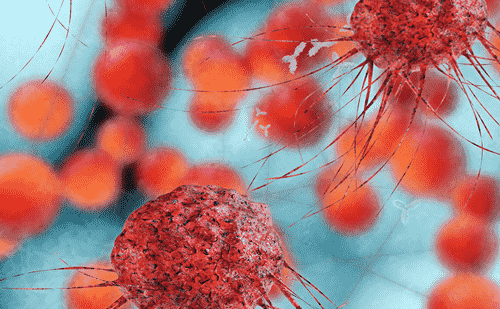Mantle cell lymphoma is an rare, aggressive B-cell lymphoma that accounts for around 6% of all non-Hodgkin’s lymphoma but is more common in patients who are aged 65 years and over.1 Its prognosis is poor, with a median overall survival (OS) of 4–5 years; however, outcomes vary widely, with some patients having very aggressive disease at presentation while other patients have an indolent clinical course.2 These different presentations make mantle cell lymphoma a challenging disease to treat. Although the disease responds to a variety of therapies, chemotherapy usually achieves only short-term remissions and there is no current standard of care. For people with relapsed or refractory mantle cell lymphoma, treatment options are limited.2
Since most standard lymphoma salvage regimens have limited activity in mantle cell lymphoma, a number of novel treatment approaches targeting known signalling pathways have been investigated, leading to the approval of new therapies from several drug classes. One involves inhibition of Bruton’s tyrosine kinase (BTK), which is a key component of B cell receptor signalling and regulates cell proliferation and survival in various B cell malignancies.3 Ibrutinib (Imbruvi®, AbbVie, North Chicago, IL, US) was the first BTK inhibitor to receive regulatory approval for the treatment of B cell malignancies after demonstrating a 68% response rate, 4 a finding that caused huge excitement in the medical community. However, its use is associated with a number of adverse events (AEs), including rash, diarrhoea, arthralgias or myalgias, atrial fibrillation, and major haemorrhage, many due to inhibition of ‘off-target’ kinases such as epidermal growth factor receptor (EGFR) and ITK. Long-term efficacy has also emerged as a problem; around one third of patients relapse in the first 2 years of treatment.5,6 In a recent real-world study, the discontinuation rate of ibrutinib was 84% at 16 months.7 This has led to the development of new BTK inhibitors.
Acalabrutinib (Calquence®, AstraZeneca, Cambridge, UK) is a second-generation, selective BTK inhibitor, designed to minimise off-target effects. In Study LY-004 (ClinicalTrials.gov Identifier: NCT02213926),8 a phase II study involving 124 patients with relapsed or refractory mantle cell lymphoma, the objective response rate was an impressive 81% at a median 15.2 months. Acalabrutinib also has fewer off-target effects than ibrutinib, resulting in a favourable safety profile.9 As a result, in October 2017 the US Food and Drug Administration (FDA) granted accelerated approval to acalabrutinib for the treatment of adult patients with mantle cell lymphoma who have received at least one prior therapy.
Long-term follow-up data from patients in study LY-004 were presented at the 61st American Society of Hematology Annual Meeting, which was held on the 7–10 December 2018 in San Diego, CA, US.10 The median follow-up was 26.3 months, and 40% of patients remained on treatment. The investigator-assessed overall response rate remained at 81%, of which 43% were complete responses. The median duration of these responses was 25.7 months. The median progression-free survival was 19.5 months, and the median OS was not reached; the estimated 24-month OS rate was 72%. An analysis of minimal residual disease (MRD) using next generation sequencing in 29 patients, found undetectable MRD in 28% of patients. Of the 60% of participants who discontinued acalabrutinib, 44% did so because of disease progression, 8% due to an AE, and 5% started subsequent anticancer therapy.
No new safety signals were observed with long-term follow-up. The most frequent AEs were primarily grade 1/2 and included headache (38%), diarrhoea (36%), fatigue (28%), cough (22%) and myalgia (21%). Grade 3/4 AEs (≥5%) included anaemia (10%), neutropenia (10%) and pneumonia (6%). There were 13 patients (10%) with 16 cardiac events, including four grade 3/4 events (3%) in one patient each, but there was no new onset of atrial fibrillation. Bleeding events occurred in 33%, the most common being contusion (13%) and petechiae (9%). All bleeding events were grade 1/2 except for three grade 3 events. Grade 3/4 infections occurred in 15% of patients, including one case of cytomegalovirus viremia and one case of pneumocystis jiroveci pneumonia (both grade 2).10 These findings were consistent with earlier studies. Of the 43 deaths (35%) on study, 23% were due to progressive disease and 5% due to AEs; none were considered to be related to acalabrutinib.
Chief investigator Michael L Wang, MD, of the University of Texas MD Anderson Cancer Center, said: ‘It’s encouraging to see the sustained duration of response in the updated analysis and the safety profile of acalabrutinib maintained consistently over time in mantle cell lymphoma patients. As we gain more and more experience with this therapy, its importance as a treatment option for relapsed or refractory mantle cell lymphoma is being more fully realised across the clinical and patient community.’11
Treatment options have been limited for patients who discontinue ibrutinib, because of either intolerance or refractory disease. These data show that we now have the option to switch patients not tolerating ibrutinib to acalabrutinib. While acalabrutinib has shown impressive results as second-line monotherapy, many experts believe that BTK inhibitors will be effective in the first-line treatment setting and that combination therapies will deliver the best outcomes for patients with mantle cell lymphoma. Acalabrutinib has also shown promising efficacy and safety in combination with rituximab plus bendamustine, 12 and is also being investigated with alternating cycles of bendamustine/rituximab and cytarabine/rituximab (ClinicalTrials.gov identifier: NCT03623373)13 in patients with previously untreated mantle cell lymphoma.
References
1. Fu S, Wang M, Lairson DR, et al. Trends and variations in mantle cell lymphoma incidence from 1995 to 2013: A comparative study between Texas and National SEER areas. Oncotarget. 2017;8:112516–29.
2. Vose JM. Mantle cell lymphoma: 2015 update on diagnosis, risk-stratification, and clinical management. Am J Hematol. 2015;90:739–45.
3. Hendriks RW, Yuvaraj S, Kil LP. Targeting Bruton’s tyrosine kinase in B cell malignancies. Nat Rev Cancer. 2014;14:219–32.
4. Dreyling M, Jurczak W, Jerkeman M, et al. Ibrutinib versus temsirolimus in patients with relapsed or refractory mantle-cell lymphoma: an international, randomised, open-label, phase 3 study. Lancet. 2016;387:770–8.
5. Stephens DM, Spurgeon SE. Ibrutinib in mantle cell lymphoma patients: glass half full? Evidence and opinion. Ther Adv Hematol. 2015;6:242–52.
6. Martin P, Maddocks K, Leonard JP, et al. Postibrutinib outcomes in patients with mantle cell lymphoma. Blood. 2016;127:1559–63.
7. Sharman J, Kabadi S, Clark J, et al. Treatment patterns and outcomes of 159 ibrutinib-treated MCL patients in the United States: a retrospective electronic medical record database and chart review study. Presented at: 61st American Society of Hematology Annual Meeting, San Diego, CA, US, 7–10 December 2018. Abstr 4163.
8. ClinicalTrials.gov. An Open-label, Phase 2 Study of ACP-196 (Acalabrutinib) in Subjects With Mantle Cell Lymphoma. ClinicalTrials.gov Identifier: NCT02213926. Available at: https://clinicaltrials.gov/ct2/show/NCT02213926 (accessed 17 January 2019).
9. Wang M, Rule S, Zinzani PL, et al. Acalabrutinib in relapsed or refractory mantle cell lymphoma (ACE-LY-004): a single-arm, multicentre, phase 2 trial. Lancet. 2018;391:659–67.
10. Wang M, Rule S, Zinzani PL, et al. Long-term follow-up of acalabrutinib monotherapy in patients with relapsed/refractory mantle cell lymphoma. Presented at: 61st American Society of Hematology Annual Meeting, San Diego, CA, US, 7–10 December 2018. Abstr 2876.
11. AstraZeneca. New long-term data on Calquence presented at ASH 2018. 2018. Available at: www.astrazeneca.com/media-centre/press-releases/2018/new-long-term-data-on-calquence-presented-at-ash-2018-03122018.html (accessed 14 January 2019).
12. Phillips TJ, Smith SD, Jurczak W, et al. Safety and efficacy of acalabrutinib plus bendamustine and rituximab in patients with treatment-naïve or relapsed/refractory mantle cell lymphoma. Presented at: 61st American Society of Hematology Annual Meeting, San Diego, CA, US, 7–10 December 2018. Abstr 4144.
13. ClinicalTrials.gov. Acalabrutinib With Alternating Cycles of Bendamustine/Rituximab and Cytarabine/Rituximab for Untreated Mantle Cell Lymphoma. ClinicalTrials.gov Identifier: NCT03623373. Available at: https://clinicaltrials.gov/ct2/show/NCT03623373 (accessed 17 January 2019).











